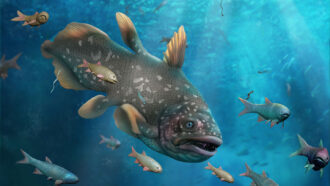‘Thunder beast’ fossils show how some mammals might have gotten big
Rather than a straightforward march, evolving to be big sometimes involved getting smaller

Extinct brontotheres like Megacerops kuwagatarhinus (illustrated) were once titans weighing a metric ton or more. But the mammals’ evolutionary history wasn’t a straight path to gigantism.
Oscar Sanisidro © 2018, KU Biodiversity Institute/The University of Kansas
By Elise Cutts
For some mammals, the evolutionary path to gigantism after the dinosaurs’ demise wasn’t always a straight road.
Species of extinct, hefty, rhinoceros-like creatures called brontotheres evolved into both bigger and smaller forms over their 22-million-year run, researchers report in the May 12 Science. But big brontotheres seem to have enjoyed relatively uncrowded ecological niches compared with their smaller kin and so were less prone to extinction, explaining the group’s overall trend toward larger bodies over time.
“It’s a more complex evolutionary world than what pure Darwinism would tell us,” says paleobiologist Juan Cantalapiedra of the University of Alcalá in Madrid. “It’s not this organized, predictable world where progress is a thing in nature and the better adapted always ended up surviving.”
After nonavian dinosaurs were wiped out about 66 million years ago, mammals got bigger — and some got really big (SN: 4/25/22). Previously no larger than cats or coyotes, some mammals rapidly transformed into titans of a metric ton or more. Brontotheres were among the first mammals to grow to enormous size — their name comes from Greek words for “thunder” and “beast.”
But while more than half of the nearly 60 known brontothere species tipped the scale at over a metric ton, the first footfalls of these “thunder beasts” weren’t thunderous at all. When the earliest brontotheres appeared in the lush forests of ancient North America and Asia in the early Eocene Epoch, roughly 56 million years ago, they were about the size of a border collie — hardly the stuff of thundering herds.
Within about 16 million years, these modest mammals had grown into a family of giants.

This dramatic transformation played out in other mammal lineages too (SN: 3/31/22). And the orthodox explanation for this trend, called Cope’s rule, holds that bigger individuals of a single species have a fitness advantage over smaller ones. Towering over predators is a good way to stay off the menu, and bigger bodies can enable bigger brains, expanded dietary options and many other advantages. “So populations will become larger over time, just because it’s better,” Cantalapiedra says.
Cope’s rule predicts that natural selection would lead to species and their lineages gradually getting larger over time. But the new study suggests that brontotheres followed a different evolutionary path to gigantism.
Cantalapiedra and colleagues tested how well three different evolutionary scenarios — including Cope’s rule — could explain the fossil record of brontotheres. They also used the fossil data to look for links between brontotheres’ size, ecology and the likelihood of going extinct or splitting into new species.
The new analysis suggests that brontothere species usually stayed about the same size until splitting off into new species, which could be either bigger or smaller than their forebears. But because smaller species branched into new species and went extinct more often, brontotheres overall tended to get bigger with time.
Comparing the family tree of brontotheres with a bonsai, Cantalapiedra says that this mechanism is a bit like letting the bonsai tree’s branches split normally while “cutting branches away from one side.” Cope’s rule, on the other hand, would be like using wires to continuously guide the tree in one direction.
“We often invoke Cope’s rule for large body size in mammals,” says Ryan Felice, an evolutionary biologist at University College London who was not involved in the study. “And maybe this is evidence saying: That’s not the end of the story.”
Beyond body size, there’s a wider question in paleobiology about how drastic evolutionary changes happen.
Going back to Cantalapiedra’s bonsai, does natural selection bend the branches of the tree of life gradually, shaping individual species á la Cope’s rule? Or do dramatic transformations happen when large-scale ecological or environmental processes cut away entire branches?
Brontotheres’ trend toward titanic proportions seems to suggest the latter. In a world with fewer big plant eaters than smaller ones, little brontotheres seem to have faced stiffer competition compared with their colossal kin. Big brontotheres won out because of their different ecology, not necessarily because bigger individuals had an advantage over smaller members of their own species, the researchers say.
Checking whether the same pattern holds for other groups of large animals would be an interesting next step, Felice says. He also suggests incorporating paleoclimate data into the analysis to look for any links between changes in climate and mammal evolution — patterns that could hint at possible rippling evolutionary effects of modern climate change.







